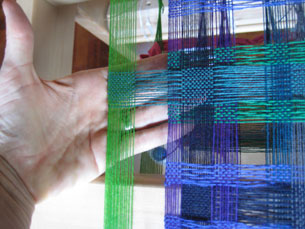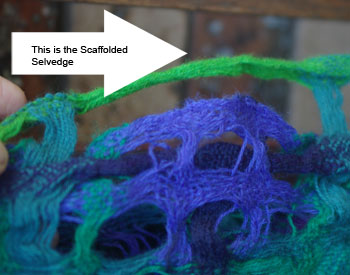 I originally intended this post to be about Industrial weaving vs handweaving! About what differences there are and how handweavers have unique design and practical tools that allow them to do all sorts of things.
I originally intended this post to be about Industrial weaving vs handweaving! About what differences there are and how handweavers have unique design and practical tools that allow them to do all sorts of things.
But I’m now waylaid. I saw the most depressingly beautiful industrially woven scarf this weekend. In a very expensive shop a scarf for only $99.00 which I could never compete with at cost. Jacquard woven in wool and lycra in a two layer double weave and large coloured circles on it, with a lovely handle. As I was weaving double weave circles at the time I was particularly struck by it.
 I’m sad at the parted ways of handweavers and industrial weavers. Handweavers generally have to teach themselves and reinvent the wheel with every woven textile. We often seem to be more aligned to the past than creating textiles for our contemporary changing world. I love learning about hand textiles and techniques of the past. I’m in awe of the textiles still made by hand in other cultures which promote their incredible skills and labour… but I still want to know what industry is doing and how new ideas and fibres are being used. Having said this handweavers have the perfect looms for experimentation and small runs. We can develop and perfect ideas before they can be run in very large lengths in industry. We can serve as a lab for industry.
I’m sad at the parted ways of handweavers and industrial weavers. Handweavers generally have to teach themselves and reinvent the wheel with every woven textile. We often seem to be more aligned to the past than creating textiles for our contemporary changing world. I love learning about hand textiles and techniques of the past. I’m in awe of the textiles still made by hand in other cultures which promote their incredible skills and labour… but I still want to know what industry is doing and how new ideas and fibres are being used. Having said this handweavers have the perfect looms for experimentation and small runs. We can develop and perfect ideas before they can be run in very large lengths in industry. We can serve as a lab for industry.
In this light I experimented with selvedges in the deflected double weave scarves. I added a selvedge extension warp and wove it to the main textile at designated spots. When felted this produced a scaffolding which is nice to wrap the scarf through when you wear it.
 On another scarf I cut the scaffolding to the the woven tags which added a nice further dimension to the edges, fluttering as you walk.
On another scarf I cut the scaffolding to the the woven tags which added a nice further dimension to the edges, fluttering as you walk.
These are modest experiments but I enjoyed doing them and now have more ideas for other selvedge treatments. The selvedge is a special area of design potential for handweavers. Remember we’re the lab. The new word for exuberant samplers!

Leave a Reply